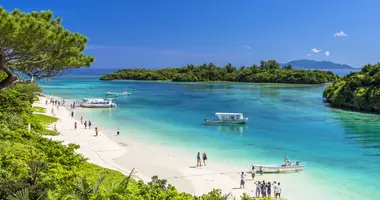Odawara 小田原
- Published on : 05/03/2019
- by : I.D.O.
- Youtube
Getaway to the castle
Odawara, a coastal town on Sagami Bay in Kanagawa Prefecture, is often overlooked in favor of its neighbor Hakone. However, its castle with its flowery park and its seaside make it a pleasant city to visit.
Just 35 min from Tokyo by Shinkansen, the Japanese bullet train, Odawara Castle is the closest castle with a keep to the capital.
A little history
Odawara, as evidenced by the existence of its castle, was an important city and it was even the economic and political center of the Kantô region throughout the 16th century thanks to the Hôjô clan. It was at the beginning of the 15th century that the founder of the clan, Hojo Soun (1432-1519, whose real name was Ise Shinkuro, was renamed Hojo Soun posthumously), conquered the lands of the province of Sagami. He established his power thereby seizing Odawara Castle and extending it to the entire Kanto region.
During the Sengoku period, the era of "warring provinces" (1450-1573), Odawara Castle was the scene of historical events of great importance. In 1590, Hideyoshi Toyotomi besieged the castle for the third time and ended up defeating the Hojo clan and reunifying the country.
Odawara Castle
The seventh-largest castle in Japan and included in 2006 in the list of "one hundred remarkable Japanese castles" of the Foundation of Japanese Castles, Odawara-jo has known many developments.
Built in 1447, it became a fortified castle during the reign of the Hojo. Destroyed by an earthquake in 1703, it was rebuilt in 1706. During the Meiji era (1869-1903) the keep and several buildings were dismantled and sold. The rest was wiped out in the Great Kanto Earthquake of 1923, as was the Imperial Villa which had been built inside the castle grounds.
In 1938, Odawara-jo has declared a "National Historic Landmark", and renovations were undertaken. In 1950, repairs were made and a park was laid out around the foundations of the donjon. The latter, rebuilt in concrete in 1960, has four floors.
Inside, documents and paintings retrace the history of the castle, and various objects are exhibited, such as crockery, sabers, or the armor of warriors of the time.
The fourth floor is surrounded by an observation deck from which one has a view of the mountains, the sea, and, on a clear day, of the Boso peninsula.
Once the keep was rebuilt, several other reconstruction works were undertaken and the three main gates were reconstructed: the Tokiwagi gate in 1971, the Akagane gate in 1997, and the Umade gate in 2009.
The castle grounds, Odawara Joshi-Koen, is famous for its plum and cherry blossom trees as well as its azaleas and wisteria. It also houses the Odawara Castle Historical Museum, a city historical and cultural museum, and a small amusement park for children.
- Also read: Odawara Ume Matsuri
The beach
Odawara's main beach is named Miyukinohama (literally "Imperial Visit Beach") in memory of Emperor Meiji's visit in 1873. Located about a 20-minute walk from Odawara Station, it is a long pebble beach that attracts bathers and fishermen.
Near the Odawara Blue Way Bridge, the fishing port provides the city with fresh fish that can be enjoyed in the many restaurants in the center and also around the port.
Odawara is also famous for its "kamaboko", a paste of steamed white fish mixed with egg white, similar to surimi and often sold in the shape of pink or white half cylinders. Moreover, not far from the sea, the small Suzuhiro Kamaboko museum offers workshops for making fish patés. The museum is located on the Hakone Tozan Line, Kazamatsuri Station, about 10 min from Odawara Station. It is open daily from 9 am to 5 pm.
Finally, since October 2017, the Enoura Observatory, an artistic complex overlooking the sea, has come to enrich the cultural heritage of Odawara.

The view of Sagami Bay is breathtaking
LWYang
Address, timetable & access
Address
Access
Odawara Castle: 9 am to 5 pm. From 9 am to 6 pm from June to August, Saturdays, Sundays, and public holidays. Closed the 2nd Wednesday of December, December 31, and January 1.



























